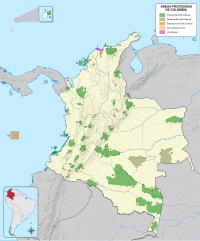Sierra Nevada de Santa Marta
The Santa Marta Páramo, a high altitude belt of montane grasslands and shrublands interspersed with marshes and acid bogs, occupies the zone between 3,300 and 5,000 m (10,827 and 16,404 ft).It is a sanctuary as well as a tourist attraction, because it offers different climate, terrain, flora and fauna environments, ranging from beaches to snowy mountain peaks.All the water courses that originate in the national park drain to the Caribbean sea whether directly (e. g. rivers Ranchería, Don Diego, Palomino, Buritaca, Guachaca, Cañas, etc.)The Quaternary of the Sierra Nevada de Santa Marta is mainly represented by colluvial-alluvial valley fill and by recent beach deposits.The coastlines of the northwestern part of the Sierra Nevada de Santa Marta are indented, reflecting the alternation of rocky headlands and deep, north-northwest trending tectonically controlled bays.The bay shores are typically steep, reflective beaches composed of very coarse sand to granules eroded from adjacent cliffs and alluvial deposits.The Sierra Nevada de Santa Marta is home to the remnants of the Native American Tairona Culture; Arhuacos, Koguis, Wiwas and Kankuamos, that live in Resguardos Indigenas (indigenous reserves) located in the mid-highlands.[13] The only safe and relatively straightforward access is from Santa Marta city to Cuchillo de San Lorenzo, but that is only to 2,800 m (9,200 ft) (although it provides excellent views of the peaks).


Pico Simón BolívarPico Cristobal ColonElevationCoordinatesColombiaIUCN categorynational parkValleduparSanta MartaSaint Elias MountainsMagdalenaLa GuajiraPico Cristóbal ColónAracatacaTropical AndesprominentCerro ParamilloAntioquia Departmentepiphyteslianasvascular plantsAttalea maripablack-fronted wood-quailking vultureAndean condorSanta Marta warblerSanta Marta parakeetcougarjaguarsquirrelTransandinomys talamancaebrocket deerecoregionsGuajira–Barranquilla xeric scrubSinú Valley dry forestsSanta Marta montane forestsendemicCloud forestsSanta Marta Páramomontane grasslands and shrublandsPáramoSpanishCordillera Oriental rangebeachesMagdalena RiverCiénaga Grande de Santa Martaindigenous peopleKoguisArhuacosKankuamosTairona CultureBiosphere reserveUNESCOCretaceousschistsgneissesquartzdioriticTertiaryQuaternarycolluvialalluvialtectonicallygranitesembaymentstombolosstacksAnolis santamartaeAtractus sanctaemartaeLepidoblepharis sanctaemartaeNative AmericanArmed turmoilpeace process carried on since 2016Ciudad PerdidaTayronaJuan MayrPico Simon BolivarColombian AndesWestern RangesSerranía de PincheFarallones de CaliParamillo MassifCentral RangesSerranía de los ChurumbelosSerranía de las MinasEastern RangesAltiplano CundiboyacenseEastern HillsSerranía de los YariguíesSerranía de las QuinchasSierra Nevada del CocuySerranía del PerijáColombian MassifSerranía de MacuiraSerranía de ChiribiqueteSerranía de la MacarenaSerranía del DariénSerranía del BaudóMontes de MaríaSerranía de San LucasProtected areas of ColombiaAmacayacuBahía PorteteChingazaCorales del Rosario y San BernardoCueva de los GuácharosDoña Juana-Cascabel Volcanic ComplexEl TuparroIsla GorgonaLas HermosasLas OrquídeasLos KatíosLos NevadosMacuiraMunchiqueNevado del HuilaOld Providence McBean LagoonParamilloPuracéSerranía de Los Churumbelos Auka-WasiSumapazTatamáUramba Bahía MálagaUtríaEl Corchal "El mono Hernández"GalerasIguaque